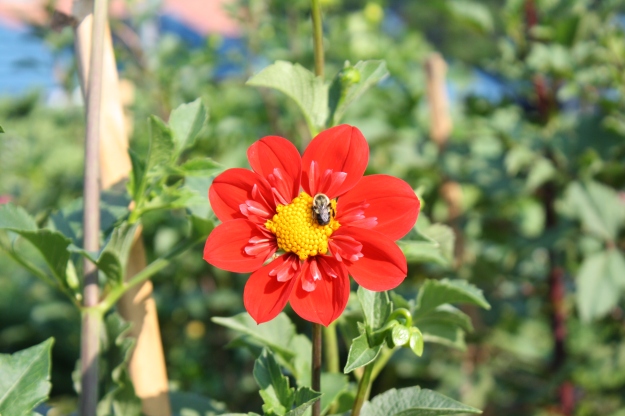Today’s photos and write-up are by student employee Adam Dubuc.
The Black Eyed Susan (Rudbeckia hirta) is probably, in my mind, one of the most picturesque and recognizable flowers in the garden. It grows throughout the United States and I remember seeing it often as a kid, thinking it was some kind of sunflower. It always seemed to signify the beginning of the end of summer- but my willingness to accept the impending fall will always be greater because of it. The Dahlia is a genus of plants that has great diversity, exhibiting some flowers that are small and compact, whereas others are large and the leaves are open relative to one another. This diversity comes from Dahlias being octoploids where most plants are diploids in their chromosomal structure. The Dahlias also don’t emit any fragrance, so they rely on their brightly colored petals to attract pollinators. Even though they’re native to Mexico, they do well here and are always a pleasure to look at.
The Dahlia is a genus of plants that has great diversity, exhibiting some flowers that are small and compact, whereas others are large and the leaves are open relative to one another. This diversity comes from Dahlias being octoploids where most plants are diploids in their chromosomal structure. The Dahlias also don’t emit any fragrance, so they rely on their brightly colored petals to attract pollinators. Even though they’re native to Mexico, they do well here and are always a pleasure to look at.  ‘Heatwave’ Agastache is a cultivar of Anise Hyssop and blooms in mid to late summer, attracting all sorts of bees, hummingbirds, and insects. The fragrance is nice also– it’s part of the mint family, and it’s deer resistant which can be suitable for any sunny garden, given that it’s perennial and can grow into a pretty large, spacious shrubby form.
‘Heatwave’ Agastache is a cultivar of Anise Hyssop and blooms in mid to late summer, attracting all sorts of bees, hummingbirds, and insects. The fragrance is nice also– it’s part of the mint family, and it’s deer resistant which can be suitable for any sunny garden, given that it’s perennial and can grow into a pretty large, spacious shrubby form. Phlox paniculata ‘David’ is a white cultivar of Phlox that gives a bright contrast and jumps out immediately. Even in a dark night with only moonlight it is pronounced among the other plants. It has a soft texture and just seems very calm to me, not too gaudy or in your face.
Phlox paniculata ‘David’ is a white cultivar of Phlox that gives a bright contrast and jumps out immediately. Even in a dark night with only moonlight it is pronounced among the other plants. It has a soft texture and just seems very calm to me, not too gaudy or in your face.  Pink Powder Puff (Calliandra emarginata) is just funny to look at, I think. Native to Mexico, it has these really goofy looking flowers that resemble exploding fireworks. It makes an awesome picture, and they flower year round in the greenhouse too, which is pretty awesome if you ask me.
Pink Powder Puff (Calliandra emarginata) is just funny to look at, I think. Native to Mexico, it has these really goofy looking flowers that resemble exploding fireworks. It makes an awesome picture, and they flower year round in the greenhouse too, which is pretty awesome if you ask me. The compost pile, to me, resembles the cyclical nature of plants – and life in general really. Even though things die, they can always be re-purposed into something new, giving nutrients and new life to the plants that come after them. I guess it all comes down to how in-depth and metaphysically you think when you look at a pile of dirt – but there is a lot that compost contributes to the garden and the plants of the future.
The compost pile, to me, resembles the cyclical nature of plants – and life in general really. Even though things die, they can always be re-purposed into something new, giving nutrients and new life to the plants that come after them. I guess it all comes down to how in-depth and metaphysically you think when you look at a pile of dirt – but there is a lot that compost contributes to the garden and the plants of the future.











